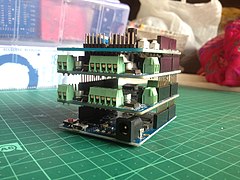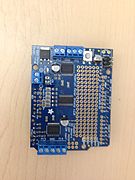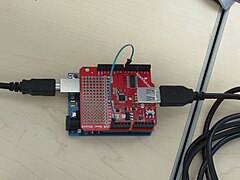Arduino
 Arduino Uno SMD R3 | |
| Developer | arduino.cc |
|---|---|
| Manufacturer | Arduino |
| Type | Single-board microcontroller |
| Operating system | None (default) / Xinu |
| CPU |
|
| Memory | SRAM |
| Storage | Flash, EEPROM |
| Website | arduino.cc |
Arduino (/ɑːrˈdwiːnoʊ/) is an Italian open-source hardware and software company, project, and user community that designs and manufactures single-board microcontrollers and microcontroller kits for building digital devices. Its hardware products are licensed under a CC BY-SA license, while the software is licensed under the GNU Lesser General Public License (LGPL) or the GNU General Public License (GPL),[1] permitting the manufacture of Arduino boards and software distribution by anyone. Arduino boards are available commercially from the official website or through authorized distributors.[2]
Arduino board designs use a variety of
The Arduino project began in 2005 as a tool for students at the Interaction Design Institute Ivrea, Italy,[3] aiming to provide a low-cost and easy way for novices and professionals to create devices that interact with their environment using sensors and actuators. Common examples of such devices intended for beginner hobbyists include simple robots, thermostats, and motion detectors.
The name Arduino comes from a bar in Ivrea, Italy, where some of the project's founders used to meet. The bar was named after Arduin of Ivrea, who was the margrave of the March of Ivrea and King of Italy from 1002 to 1014.[4]
History
Founding

The Arduino project was started at the
The initial Arduino core team consisted of Massimo Banzi, David Cuartielles, Tom Igoe, Gianluca Martino, and David Mellis.[3]
Following the completion of the platform, lighter and less expensive versions were distributed in the open-source community. It was estimated in mid-2011 that over 300,000 official Arduinos had been commercially produced,[6] and in 2013 that 700,000 official boards were in users' hands.[7]
Trademark dispute
In early 2008, the five co-founders of the Arduino project created a company, Arduino LLC,[8] to hold the trademarks associated with Arduino. The manufacture and sale of the boards were to be done by external companies, and Arduino LLC would get a royalty from them. The founding bylaws of Arduino LLC specified that each of the five founders transfer ownership of the Arduino brand to the newly formed company.[citation needed]
At the end of 2008, Gianluca Martino's company, Smart Projects, registered the Arduino trademark in Italy and kept this a secret from the other co-founders for about two years. This was revealed when the Arduino company tried to register the trademark in other areas of the world (they originally registered only in the US), and discovered that it was already registered in Italy. Negotiations with Martino and his firm to bring the trademark under the control of the original Arduino company failed. In 2014, Smart Projects began refusing to pay royalties. They then appointed a new CEO, Federico Musto, who renamed the company Arduino SRL and created the website arduino.org, copying the graphics and layout of the original arduino.cc. This resulted in a rift in the Arduino development team.[9][10][11]
In January 2015, Arduino LLC filed a lawsuit against Arduino SRL.[12]
In May 2015, Arduino LLC created the worldwide trademark Genuino, used as brand name outside the United States.[13]
At the World Maker Faire in New York on 1 October 2016, Arduino LLC co-founder and CEO Massimo Banzi and Arduino SRL CEO Federico Musto announced the merger of the two companies.[14] Around that same time, Massimo Banzi announced that in addition to the company a new Arduino Foundation would be launched as "a new beginning for Arduino", but this decision was withdrawn later.[15][16]
In April 2017,
This section may be confusing or unclear to readers. In particular, the article only mentioned and explained the origin of the american LLC and the italian SRL companies. This is the first time the german AG is mentioned without clarifying with which of those two parties it is associated.. (November 2022) |
By 2017 Arduino AG owned many Arduino trademarks. In July 2017 BCMI, founded by Massimo Banzi, David Cuartielles, David Mellis and Tom Igoe, acquired Arduino AG and all the Arduino trademarks. Fabio Violante is the new CEO replacing Federico Musto, who no longer works for Arduino AG.[19][20]
Post-dispute
In October 2017, Arduino announced its partnership with Arm Holdings (ARM). The announcement said, in part, "ARM recognized independence as a core value of Arduino ... without any lock-in with the ARM architecture". Arduino intends to continue to work with all technology vendors and architectures.[21] Under Violante's guidance, the company started growing again and releasing new designs. The Genuino trademark was dismissed and all products were branded again with the Arduino name.
In August 2018, Arduino announced its new open source command line tool (arduino-cli), which can be used as a replacement of the IDE to program the boards from a shell.[22]
In February 2019, Arduino announced its IoT Cloud service as an extension of the Create online environment.[23]
As of February 2020, the Arduino community included about 30 million active users based on the IDE downloads.[24]
Hardware

Arduino is open-source hardware. The hardware reference designs are distributed under a Creative Commons Attribution Share-Alike 2.5 license and are available on the Arduino website. Layout and production files for some versions of the hardware are also available.
Although the hardware and software designs are freely available under copyleft licenses, the developers have requested the name Arduino to be exclusive to the official product and not be used for derived works without permission. The official policy document on the use of the Arduino name emphasizes that the project is open to incorporating work by others into the official product.[25] Several Arduino-compatible products commercially released have avoided the project name by using various names ending in -duino.[26]

Most Arduino boards consist of an
Arduino microcontrollers are pre-programmed with a

The Arduino board exposes most of the microcontroller's I/O pins for use by other circuits. The Diecimila,[a] Duemilanove,[b] and current Uno[c] provide 14 digital I/O pins, six of which can produce pulse-width modulated signals, and six analog inputs, which can also be used as six digital I/O pins. These pins are on the top of the board, via female 0.1-inch (2.54 mm) headers. Several plug-in application shields are also commercially available. The Arduino Nano and Arduino-compatible Bare Bones Board[33] and Boarduino[34] boards may provide male header pins on the underside of the board that can plug into solderless breadboards.
Many Arduino-compatible and Arduino-derived boards exist. Some are functionally equivalent to an Arduino and can be used interchangeably. Many enhance the basic Arduino by adding output drivers, often for use in school-level education,[35] to simplify making buggies and small robots. Others are electrically equivalent, but change the form factor, sometimes retaining compatibility with shields, sometimes not. Some variants use different processors, of varying compatibility.
Official boards
The original Arduino hardware was manufactured by the Italian company Smart Projects.[36] Some Arduino-branded boards have been designed by the American companies SparkFun Electronics and Adafruit Industries.[37] As of 2016[update], 17 versions of the Arduino hardware have been commercially produced.
-
Arduino RS232[38]
(male pins) -
Arduino Diecimila[39]
-
Arduino Duemilanove[40]
(rev 2009b) -
Arduino Leonardo[44]
-
Arduino pro micro (ATmega32U4)
-
Arduino Pro[45]
(No USB) -
Arduino Mega[46]
-
Arduino LilyPad 00[48]
(rev 2007) (No USB) -
Arduino Robot[49]
-
Arduino Esplora[50]
-
Arduino Ethernet[51]
(AVR + W5100) -
Arduino Yún[52]
(AVR + AR9331) -
Arduino DueARM Cortex-M3core)
-
Arduino GIGA R1 WiFi (Dual core ARM Cortex-M7 + ARM Cortex-M4 cores + Murata 1DX)
Shields
Arduino and Arduino-compatible boards use printed circuit expansion boards called shields, which plug into the normally supplied Arduino pin headers.
-
Some shields offer stacking headers which allow multiple shields to be stacked on top of an Arduino board. Here, a prototyping shield is stacked on twoAdafruitmotor shield V2s.
-
Screw-terminal breakout shield in a wing-type format, allowing bare-end wires to be connected to the board without requiring any specialized pins
-
Adafruit Datalogging Shield with aSecure Digital(SD) card slot and real-time clock (RTC) chip along with some space for adding components and modules for customization
-
Adafruit Motor Shield with screw terminals for connection to motors. Officially discontinued, this shield may still be available through unofficial channels.
-
The Adafruit Motor Shield V2 uses I2C, requiring vastly fewer digital I/O pins than attaching each motor directly.
-
A USB host shield which allows an Arduino board to communicate with a USB device such as a keyboard or a mouse
Software
A program for Arduino hardware may be written in any
Legacy IDE
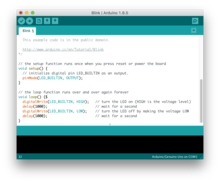 Screenshot of Arduino IDE showing Blink program | |
| Developer(s) | Arduino Software |
|---|---|
| Stable release | 1.8.19
/ 21 December 2021[61] |
| Written in | ARM |
| Type | Integrated development environment |
| License | LGPL or GPL license |
| Website | www |
The Arduino
The Arduino IDE supports the languages
From version 1.8.12, Arduino IDE windows compiler supports only Windows 7 or newer OS. On Windows Vista or older one gets "Unrecognized Win32 application" error when trying to verify/upload program. To run IDE on older machines, users can either use version 1.8.11, or copy "arduino-builder" executable from version 11 to their current install folder as it is independent from IDE.[63]
IDE 2.0
| Developer(s) | Arduino Software |
|---|---|
| Stable release | 2.3.2
/ 20 February 2024[64] |
| Written in | TypeScript, JavaScript, Go |
| Operating system | Microsoft Windows, macOS, Linux |
| Platform | x86-64 |
| Type | Integrated development environment |
| License | GNU Affero General Public License v3.0 |
| Website | www |
An initial alpha preview of a new Arduino IDE was released on October 18, 2019, as the Arduino Pro IDE. The beta preview was released on March 1, 2021, renamed IDE 2.0. On September 14, 2022, the Arduino IDE 2.0 was officially released as stable.[65]
The system still uses Arduino CLI (Command Line Interface), but improvements include a more professional development environment and autocompletion support.[66] The application frontend is based on the Eclipse Theia Open Source IDE. Its main new features are:[67]
- Modern, fully featured development environment
- New Board Manager
- New Library Manager
- Board List
- Basic Auto-Completion
- Serial Monitor
- Dark Mode
Sketch
A sketch is a program written with the Arduino IDE.[68] Sketches are saved on the development computer as text files with the file extension .ino. Arduino Software (IDE) pre-1.0 saved sketches with the extension .pde.
A minimal Arduino C/C++ program consists of only two functions:[69]
setup(): This function is called once when a sketch starts after power-up or reset. It is used to initialize variables, input and output pin modes, and other libraries needed in the sketch. It is analogous to the functionmain().[70]loop(): Aftersetup()function exits (ends), theloop()function is executed repeatedly in the main program. It controls the board until the board is powered off or is reset. It is analogous to the functionwhile(1).[71]
- Blink example
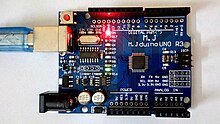
Most Arduino boards contain a
pinMode(), digitalWrite(), and delay(), which are provided by the internal libraries included in the IDE environment.[73][74][75]const int LED_PIN = 13; // Pin number attached to LED.
void setup() {
pinMode(LED_PIN, OUTPUT); // Configure pin 13 to be a digital output.
}
void loop() {
digitalWrite(LED_PIN, HIGH); // Turn on the LED.
delay(1000); // Wait 1 second (1000 milliseconds).
digitalWrite(LED_PIN, LOW); // Turn off the LED.
delay(1000); // Wait 1 second.
}
Libraries
The open-source nature of the Arduino project has facilitated the publication of many free software libraries that other developers use to augment their projects.
Operating systems/threading
There is a Xinu OS port for the ATmega328P (Arduino Uno and others with the same chip), which includes most of the basic features.[76] The source code of this version is freely available.[77]
There is also a threading tool, named Protothreads. Protothreads are described as "extremely lightweight stackless threads designed for severely memory constrained systems, such as small embedded systems or wireless sensor network nodes.[78]
There is a port of FreeRTOS for the Arduino.[79] This is available from the Arduino Library Manager. It is compatible with a number of boards, including the Uno.
Applications
- Arduboy, a handheld game console based on Arduino
- Arduinome, a MIDI controller device that mimics the Monome
- Ardupilot, drone software and hardware
- ArduSat, a cubesat based on Arduino
- C-STEM Studio, a platform for hands-on integrated learning of computing, science, technology, engineering, and mathematics (C-STEM) with robotics
- Data loggers for scientific research[80][81][82][83]
- OBDuino, a trip computer that uses the on-board diagnostics interface found in most modern cars
- OpenEVSE an open-source electric vehicle charger
- XOD, a visual programming language for Arduino
Simulation
- Tinkercad, an analog and digital simulator supporting Arduino Simulation, which is most commonly used to create 3D models
- Wokwi, a digital and free to use simulator for Arduino boards
Recognitions
The Arduino project received an honorary mention in the Digital Communities category at the 2006 Prix Ars Electronica.[84]
The Arduino Engineering Kit won the Bett Award for "Higher Education or Further Education Digital Services" in 2020.[85]
See also
Explanatory notes
References
- ^ "Getting Started: FOUNDATION > Introduction". arduino.cc. Archived from the original on 2017-08-29. Retrieved 2017-05-23.
- ^ "Arduino - Home". www.arduino.cc. Retrieved 2022-10-27.
- ^ a b c Kushner, David (2011-10-26). "The Making of Arduino". IEEE Spectrum.
- ^ Lahart, Justin (27 November 2009). "Taking an Open-Source Approach to Hardware". The Wall Street Journal. Retrieved 2014-09-07.
- ^ a b Barragán, Hernando (2016-01-01). "The Untold History of Arduino". arduinohistory.github.io. Retrieved 2016-03-06.
- ^ "How many Arduinos are "in the wild?" About 300,000". Adafruit Industries. May 15, 2011. Retrieved 2013-05-26.
- ^ "Arduino FAQ – With David Cuartielles". Malmö University. April 5, 2013. Archived from the original on 2017-09-06. Retrieved 2014-03-24.
- ^ "Business Entity Summary for Arduino LLC". Mass.gov. State of Massachusetts.
- ^ Allan, Alasdair (6 March 2015). "Arduino Wars: Group Splits, Competing Products Revealed?". makezine.com. Maker Media, Inc. Retrieved 21 April 2015.
- ^ Banzi, Massimo (19 March 2015). "Massimo Banzi: Fighting for Arduino". makezine.com. Maker Media, Inc. Retrieved 21 April 2015.
- ^ Williams, Elliot (28 March 2015). "Arduino SRL to Distributors: "We're the Real Arduino"". Hackaday.com. Retrieved 21 April 2015.
- ^ "Arduino LLC vs Arduino SRL lawsuit; United States Courts Archive". Archived from the original on 2017-07-09. Retrieved 20 February 2018.
- ^ "Arduino Announces New Brand, Genuino, Manufacturing Partnership with Adafruit". Make. 16 May 2015. Retrieved 17 May 2015.
- ^ "Arduino Blog – Two Arduinos become one". Arduino Blog. October 2016. Retrieved 2016-10-02.
- ^ "Free Arduino | Make". Make: DIY Projects and Ideas for Makers. 2017-06-09. Retrieved 2017-12-22.
- ^ "The Arduino Foundation: What's Up?". Hackaday. 2017-06-19. Retrieved 2017-12-22.
- ^ "Arduino's New CEO, Federico Musto, May Have Fabricated His Academic Record". WIRED. Retrieved 2017-12-22.
- ^ Biggs, John. "CEO controversy mars Arduino's open future". TechCrunch. Retrieved 2017-12-22.
- ^ "Arduino Blog – A new era for Arduino begins today". Arduino Blog. 28 July 2017. Retrieved 19 Jan 2018.
- ^ Davis, Tom (31 July 2017). "BCMI Acquires Arduino AG and Makers Breathe a Sigh of Relief". techwombat.com. Retrieved 29 November 2018.
- ^ "Arduino reborn partners with ARM". Electronics Weekly. 2017-10-06. Retrieved 2017-11-03.
- ^ "Announcing the Arduino Command Line Interface (CLI)". Arduino Blog. 2018-08-24. Retrieved 2020-06-23.
- ^ "Announcing the Arduino IoT Cloud Public Beta". Arduino Blog. 2019-02-06. Retrieved 2020-06-23.
- ^ Emilio, Maurizio Di Paolo (2020-02-04). "Open-source HW in the Modern Era: Interview of Arduino's CEO Fabio Violante". EE Times Europe. Retrieved 2020-06-23.
- ^ "Policy". Arduino.cc. Retrieved 2013-01-18.
- ^ "Freeduino Open Designs". Freeduino.org. Archived from the original on 2008-04-10. Retrieved 2008-03-03.
- ^ "Hardware Index". Arduino Project. Retrieved 2013-12-10.
- ^ "Chip Hall of Fame: Atmel ATmega8". IEEE Spectrum: Technology, Engineering, and Science News. Retrieved 2017-10-10.
- ^ "Arduino - Products". www.arduino.cc. Retrieved 20 February 2018.
- ^ "Microcontroller Maniacs Rejoice: Arduino Finally Releases the 32-Bit Due". Wired. Retrieved 20 February 2018.
- ISSN 0392-2790.
- ^ "Optiboot Bootloader for Arduino and Atmel AVR". GitHub. Retrieved 2015-10-01.
- ^ "Bare Bones Board (BBB) Kit". moderndevice.com. Archived from the original on 30 July 2013. Retrieved 29 November 2018.
- ^ "DC Boarduino (Arduino compatible) Kit (w/ATmega328) - v1.0". adafruit.com. Retrieved 29 November 2018.
- S2CID 181368197.
- ^ "Redirect..." smartprj.com. Archived from the original on 2016-03-05. Retrieved 2011-05-03.
- OCLC 1328333803.
- ^ "Arduino - ArduinoBoardSerial". www.arduino.cc. Retrieved 20 February 2018.
- ^ "Arduino - ArduinoBoardDiecimila". www.arduino.cc. Retrieved 20 February 2018.
- ^ "Arduino - ArduinoBoardDuemilanove". www.arduino.cc. Retrieved 20 February 2018.
- ^ "Arduino Uno Rev3". www.arduino.cc. Retrieved 20 February 2018.
- ^ Smith, (c) 2018, W.A. "Differences Between the Arduino Uno Revision 2 and Revision 3". startingelectronics.org. Retrieved 20 February 2018.
{{cite web}}: CS1 maint: multiple names: authors list (link) CS1 maint: numeric names: authors list (link) - ^ "Arduino - ArduinoBoardUnoSMD". www.arduino.cc. Retrieved 20 February 2018.
- ^ "Arduino Leonardo with Headers". www.arduino.cc. Retrieved 20 February 2018.
- ^ "Arduino Pro". www.arduino.cc. Retrieved 20 February 2018.
- ^ "Arduino Mega official webpage (arduino.cc)". Retrieved 20 February 2018.
- ^ "Arduino Nano". www.arduino.cc. Retrieved 20 February 2018.
- ^ "LilyPad Arduino Main Board". www.arduino.cc. Retrieved 20 February 2018.
- ^ "Arduino Robot". www.arduino.cc. Retrieved 20 February 2018.
- ^ "Arduino Esplora". www.arduino.cc. Retrieved 20 February 2018.
- ^ "Arduino Ethernet Rev3 without PoE". www.arduino.cc. Retrieved 20 February 2018.
- ^ "Arduino Yún". www.arduino.cc. Retrieved 20 February 2018.
- ^ "Arduino Due". www.arduino.cc. Retrieved 20 February 2018.
- ^ "Arduino - ArduinoShields". www.arduino.cc. Retrieved 2017-10-04.
- ^ "Arduino breadboard shield: $10 & 10 mins". todbot blog. 11 July 2006.
- ^ "Arduino Shields for Prototyping". tigoe.net. Archived from the original on 2017-07-02. Retrieved 2011-09-16.
- ^ Oxer, Jonathan. "Arduino Shield list". Retrieved 5 Nov 2013.
- ^ "Using Atmel Studio for Arduino development". Megunolink.com. Archived from the original on 2013-01-28. Retrieved 2013-01-18.
- ^ "Using AVR Studio for Arduino development". Engblaze.com. Archived from the original on 2012-08-28. Retrieved 2013-01-18.
- ^ "Ch Arduino". Retrieved 2016-10-07.
- ^ "Releases · arduino/Arduino · GitHub". GitHub. Retrieved 12 November 2022.
- ^ "arduino/Arduino". August 27, 2020 – via GitHub.
- ^ "arduino/Arduino". May 5, 2021 – via Arduino.cc.
- ^ "Releases · arduino/arduino-ide · GitHub". GitHub. Retrieved 20 February 2024.
- ^ "It's here: please welcome Arduino IDE 2.0". 14 September 2022. Retrieved 12 November 2022.
- ^ Williams, Al (21 October 2019). "The Arduino IDE Finally Grows Up". Hackaday. Retrieved 26 October 2019.
- ^ "Introducing new Arduino Pro IDE with advanced features". Seed Studio. 21 October 2019. Retrieved 26 October 2019.
- ISBN 978-0071784221.
- ^ "Arduino - BareMinimum". www.arduino.cc. Retrieved 20 February 2018.
- ^ "setup() - Arduino Reference". www.arduino.cc.
- ^ "loop() - Arduino Reference". www.arduino.cc.
- ^ "Blink Tutorial". Arduino.cc.
- ^ "pinMode() - Arduino Reference". www.arduino.cc.
- ^ "digitalWrite() - Arduino Reference". www.arduino.cc.
- ^ "delay() - Arduino Reference". www.arduino.cc.
- ^ "xinu-avr: The Xinu OS for AVR ATmega328P". se.fi.uncoma.edu.ar.
- ^ "xinu-arduino". October 9, 2022 – via GitHub.
- ^ Dunkels, A.; Schmidt, O.; Voigt, T. (2005). Using Protothreads for Sensor Node Programming. Proceedings of the REALWSN 2005 Workshop on Real-World Wireless Sensor Networks Presented at the REALWSN 2005 Workshop on Real-World Wireless Sensor Networks.
- ^ "FreeRTOS for Arduino". www.arduino.cc.
- PMID 29425185.
- ISSN 0360-1323.
- PMID 26999132.
- PMID 27089337.
- ^ "Ars Electronica Archiv". Archived from the original on 2019-06-30. Retrieved 2015-03-27.
- ^ "Arduino Education nominated for Bett Award". Arduino Blog. 2020-01-20. Retrieved 2020-07-01.
Further reading
- Banzi, Massimo; Shiloh, Michael (2022). Make: Getting Started With Arduino: The Open Source Electronics Prototyping Platform (4th ed.). Make Community. ISBN 978-1680456936.
- Blum, Jeremy (2019). Exploring Arduino: Tools and Techniques for Engineering Wizardry (2nd ed.). ISBN 978-1119405375.
- Boxall, John (2021). Arduino Workshop: A Hands-On Introduction with 65 Projects (2nd ed.). ISBN 978-1718500587.
- Karvinen, Tero; Karvinen, Kimmo; Valtokari, Ville (2014). Make: Sensors (1st ed.). Make Community. ISBN 978-1449368104.
- Monk, Simon (2018). Programming Arduino Next Steps: Going Further with Sketches (2nd ed.). ISBN 978-1260143249.
- Monk, Simon (2022). Programming Arduino: Getting Started with Sketches (3rd ed.). McGraw-Hill Education. ISBN 978-1264676989.
- Nussey, John (2018). Arduino For Dummies (2nd ed.). John Wiley & Sons. ISBN 978-1119489542.
- Purdum, Jack (2015). Beginning C for Arduino: Learn C Programming for the Arduino (2nd ed.). ISBN 978-1484209417.
- Schmidt, Maik (2015). Arduino: A Quick Start Guide (2nd ed.). ISBN 978-1941222249.
External links
- Official website
- How Arduino is open sourcing imagination, a TED talk by creator Massimo Banzi
- Evolution tree for Arduino
- Arduino Cheat Sheet
- Arduino Dimensions and Hole Patterns
- Arduino Shield Template
- Arduino Board Pinout Diagrams: Due, Esplora, Leonardo, Mega, Micro, Mini, Pro Micro, Pro Mini, Uno, Yun
- Historical
- Arduino – The Documentary (2010): IMDb, Vimeo
- Massimo Banzi interviews: Triangulation 110, FLOSS 61
- Untold History of Arduino – Hernando Barragán
- Lawsuit documents from Arduino LLC vs. Arduino S.R.L. et al. – United States Courts Archive

![Arduino RS232[38] (male pins)](http://upload.wikimedia.org/wikipedia/commons/thumb/6/6c/Arduino316.jpg/259px-Arduino316.jpg)
![Arduino Diecimila[39]](http://upload.wikimedia.org/wikipedia/commons/thumb/9/96/Arduino_Diecimila_6.jpg/240px-Arduino_Diecimila_6.jpg)
![Arduino Duemilanove[40] (rev 2009b)](http://upload.wikimedia.org/wikipedia/commons/thumb/0/05/Arduino_Duemilanove_2009b.jpg/240px-Arduino_Duemilanove_2009b.jpg)
![Arduino Uno R2[41][42]](http://upload.wikimedia.org/wikipedia/commons/thumb/3/3a/Arduino_UNO_unpacked.jpg/270px-Arduino_UNO_unpacked.jpg)
![Arduino Uno SMD R3[43]](http://upload.wikimedia.org/wikipedia/commons/thumb/3/38/Arduino_Uno_-_R3.jpg/180px-Arduino_Uno_-_R3.jpg)
![Arduino Leonardo[44]](http://upload.wikimedia.org/wikipedia/commons/thumb/3/38/Arduino_Leonardo.jpg/270px-Arduino_Leonardo.jpg)
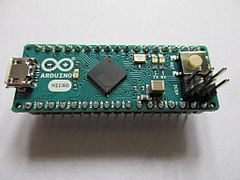

![Arduino Pro[45] (No USB)](http://upload.wikimedia.org/wikipedia/commons/thumb/a/af/Arduino_Pro.jpg/180px-Arduino_Pro.jpg)
![Arduino Mega[46]](http://upload.wikimedia.org/wikipedia/commons/thumb/0/01/Arduino_Mega.jpg/240px-Arduino_Mega.jpg)
![Arduino Nano[47] (DIP-30 footprint)](http://upload.wikimedia.org/wikipedia/commons/thumb/8/8d/Arduino_Nano.jpg/77px-Arduino_Nano.jpg)
![Arduino LilyPad 00[48] (rev 2007) (No USB)](http://upload.wikimedia.org/wikipedia/commons/thumb/e/ec/LilyPad_Arduino_Main_Board.JPG/240px-LilyPad_Arduino_Main_Board.JPG)
![Arduino Robot[49]](http://upload.wikimedia.org/wikipedia/commons/thumb/5/51/Arduino_Robot_Top.jpg/180px-Arduino_Robot_Top.jpg)
![Arduino Esplora[50]](http://upload.wikimedia.org/wikipedia/commons/thumb/2/2f/Arduino_Esplora.jpg/403px-Arduino_Esplora.jpg)
![Arduino Ethernet[51] (AVR + W5100)](http://upload.wikimedia.org/wikipedia/commons/thumb/1/16/Arduino_Ethernet_Board.jpg/270px-Arduino_Ethernet_Board.jpg)
![Arduino Yún[52] (AVR + AR9331)](http://upload.wikimedia.org/wikipedia/commons/thumb/1/1d/ArduinoYun.jpg/240px-ArduinoYun.jpg)
![Arduino Due[53] (ARM Cortex-M3 core)](http://upload.wikimedia.org/wikipedia/commons/thumb/3/36/ArduinoDue_Front.jpg/338px-ArduinoDue_Front.jpg)

